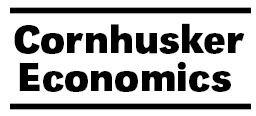Agricultural Economics, Department of

Cornhusker Economics
Date of this Version
4-3-2019
Document Type
Newsletter Issue
Citation
agecon.unl.edu/cornhuskereconomics
Abstract
At the beginning of the crop year crop producers face unknown yields and prices resulting in a large range of end of season (fall) net income. Producers can chose to participate in risk management tools, resulting in a reshaping of the fall net income distribution. Two of the most common tools are crop insurance and pre-harvest hedging (hereafter referred to as hedging). The most common crop insurance policy sold today is Revenue Protection (RP) where both yield and prices are insured. RP policy represents an intriguing crop insurance contract since it not only insures against price declines between spring and fall but also price increases from spring to fall.1 Choosing to participate in (and the level of) risk management tools comes from the desire to achieve farm business goals. Risk management stems from the goal of farm survival. Structuring risk management decisions around the goal of achieving the highest beginning of the year expected farm net income along with farm survival implies that under no circumstances risk management strategies that weaken the probability of farm survival will be taken. In other words “You will find out who is swimming naked when the tide goes out” (Warren Buffet).

